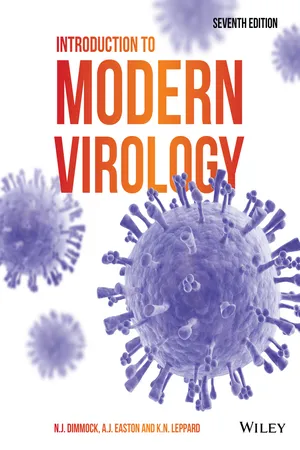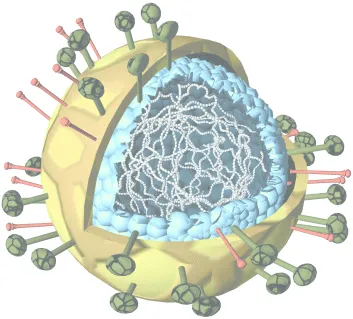
- English
- ePUB (mobile friendly)
- Available on iOS & Android
eBook - ePub
Introduction to Modern Virology
About this book
Praised forits clarity of presentation and accessibility, Introduction to Modern Virology has been a successful student text for over 30 years. It provides a broad introduction to virology, which includes the nature of viruses, the interaction of viruses with their hosts and the consequences of those interactions that lead to the diseases we see. This new edition contains a number of important changes and innovations including:
- The consideration of immunology now covers two chapters, one on innate immunity and the other on adaptive immunity, reflecting the explosion in knowledge of viral interactions with these systems.
- The coverage of vaccines and antivirals has been expanded and separated into two new chapters to reflect the importance of these approaches to prevention and treatment.
- Virus infections in humans are considered in more detail with new chapters on viral hepatitis, influenza, vector-borne diseases, and exotic and emerging viral infections, complementing an updated chapter on HIV.
- The final section includes three new chapters on the broader aspects of the influence of viruses on our lives, focussing on the economic impact of virus infections, the ways we can use viruses in clinical and other spheres, and the impact that viruses have on the planet and almost every aspect of our lives.
A good basic understanding of viruses is important for generalists and specialists alike. The aim of this book is to make such understanding as accessible as possible, allowing students across the biosciences spectrum to improve their knowledge of these fascinating entities.
Frequently asked questions
Yes, you can cancel anytime from the Subscription tab in your account settings on the Perlego website. Your subscription will stay active until the end of your current billing period. Learn how to cancel your subscription.
No, books cannot be downloaded as external files, such as PDFs, for use outside of Perlego. However, you can download books within the Perlego app for offline reading on mobile or tablet. Learn more here.
Perlego offers two plans: Essential and Complete
- Essential is ideal for learners and professionals who enjoy exploring a wide range of subjects. Access the Essential Library with 800,000+ trusted titles and best-sellers across business, personal growth, and the humanities. Includes unlimited reading time and Standard Read Aloud voice.
- Complete: Perfect for advanced learners and researchers needing full, unrestricted access. Unlock 1.4M+ books across hundreds of subjects, including academic and specialized titles. The Complete Plan also includes advanced features like Premium Read Aloud and Research Assistant.
We are an online textbook subscription service, where you can get access to an entire online library for less than the price of a single book per month. With over 1 million books across 1000+ topics, we’ve got you covered! Learn more here.
Look out for the read-aloud symbol on your next book to see if you can listen to it. The read-aloud tool reads text aloud for you, highlighting the text as it is being read. You can pause it, speed it up and slow it down. Learn more here.
Yes! You can use the Perlego app on both iOS or Android devices to read anytime, anywhere — even offline. Perfect for commutes or when you’re on the go.
Please note we cannot support devices running on iOS 13 and Android 7 or earlier. Learn more about using the app.
Please note we cannot support devices running on iOS 13 and Android 7 or earlier. Learn more about using the app.
Yes, you can access Introduction to Modern Virology by Nigel J. Dimmock,Andrew J. Easton,Keith N. Leppard in PDF and/or ePUB format, as well as other popular books in Biological Sciences & Immunology. We have over one million books available in our catalogue for you to explore.
Information
Part I
The Nature of Viruses
- 1 | Towards a definition of a virus
- 2 | The structure of virus particles
- 3 | Classification of viruses
- 4 | The evolution of viruses
- 5 | Techniques for studying viruses

Chapter 1
Towards a Definition of a Virus
Viruses occur universally, but they can only be detected indirectly. Viruses are obligate intracellular parasites that require a host within which they replicate. Although they are well known for causing disease, most viruses coexist peacefully with their hosts.
Chapter 1 Outline
- 1.1 Discovery of viruses
- 1.2 Multiplication of viruses
- 1.3 The virus multiplication cycle
- 1.4 Viruses can be defined in chemical terms
- 1.5 Multiplication of bacterial and animal viruses is fundamentally similar
- 1.6 Viruses can be manipulated genetically
- 1.7 Properties of viruses
- 1.8 Origin of viruses
Viruses are arguably the most ubiquitous and widespread group of organisms on the planet, with every animal, plant and protist species susceptible to infection. The efficiency of replication demonstrated by viruses is such that the infection of a single host can generate more new viruses than there are individuals in the host population. For example, a single human infected with influenza virus can shed sufficient virus particles to be theoretically capable of infecting the entire human population. While not every species has been examined for the presence of viruses, those that have been tested have all yielded up new virus isolates. Further, not only do viruses occur universally but each species has its own specific range of viruses that, by and large, infects only that species. In recent years, the application of new nucleic acid sequencing techniques has demonstrated that a vast array of previously unknown viruses remains to be studied.
Current estimates of the number of individual viruses on earth suggest that they considerably exceed the total number of stars in the known universe, i.e. more than 1023 (100 sextillion). This vast number raises questions as to what the viruses are doing there, and what selective advantage, if any, they afford to the species that host them. The answer to the first of these is the same as if the question was posed about any organism – it is simply occupying a particular environmental niche which, in the case of a virus, is another species. The answer to whether or not any benefit accrues for hosting a virus is usually not known, though the adverse effects of virus infections are all too well known. However, it is clear that, despite their adverse effects and the dramatic depictions of viruses in popular media and cinema, viruses have not made their hosts extinct.
1.1 Discovery of Viruses
Although much is known about viruses (Box 1.1), it is instructive and interesting to consider how this knowledge came about. It was only just over 100 years ago, at the end of the 19th century, that the germ theory of disease was formulated, and pathologists were then confident that a causative micro-organism would be found for each infectious disease. Further, they believed that these agents of disease could be seen with the aid of a microscope, could be cultivated on a nutrient medium, and could be retained by filters. There were, admittedly, a few organisms which were so fastidious that they could not be cultivated in the laboratory but the other two criteria were satisfied. However, in 1892, Dmitri Iwanowski was able to show that the causal agent of a mosaic disease of tobacco plants, manifesting as a discoloration of the leaf, passed through a bacteria-proof filter, and could not be seen or cultivated. Iwanowski was unimpressed by his discovery, but Beijerinck repeated the experiments in 1898, and became convinced that this represented a new form of infectious agent which he termed contagium vivum fluidum, what we now know as a virus. In the same year, Loeffler and Frosch came to the same conclusion regarding the cause of foot-and-mouth disease. Furthermore, because foot-and-mouth disease could be passed from animal to animal, with great dilution at each passage, the causative agent had to be reproducing and thus could not be a bacterial toxin. Viruses of other animals were soon discovered. Ellerman and Bang reported the cell-free transmission of chicken leukaemia in 1908, and in 1911 Rous discovered that solid tumours of chickens could be transmitted by cell-free filtrates. These were the first indications that some viruses can cause cancer (see Chapter 25).
Box 1.1 Properties Common to All Viruses
- Viruses have a nucleic acid genome of either DNA or RNA.
- Compared with a cell genome, viral genomes are small, but genomes of different viruses range in size by over 100-fold (ca 3000 nt to 1,200,000 bp)
- Small genomes make small particles – again with a 100-fold size range.
- Viral genomes are associated with protein that at its simplest forms the virus particle, but in some viruses this nucleoprotein is surrounded by further protein or a lipid bilayer.
- The outermost proteins of the virus particle allow the virus to recognise the correct host cell and gain entry.
- Viruses can only reproduce in living cells: they are obligate parasites.
Finally, bacterial viruses were discovered. In 1915, Twort published an account of a glassy transformation of micrococci. He had been trying to culture the smallpox agent on agar plates but the only growth obtained was that of some contaminating micrococci. Following prolonged incubation, some of the colonies took on a glassy appearance, and once this occurred no bacteria could be subcultured from the affected colonies. If some of the glassy material was added to normal colonies, they too took on a similar appearance, even if the glassy material was first passed through very fine filters to exclude all but the smallest material. Among the suggestions that Twort put forward to explain the phenomenon were either the existence of a bacterial virus or the secretion by the bacteria of an enzyme which could lyse the producing cells. This idea of self-destruction by secreted enzymes was to prove a controversial topic over the next decade. In 1917, d'Hérelle observed a similar phenomenon in dysentery bacilli. He observed clear spots on lawns of such cells, and resolved to find an explanation for them. Upon noting the lysis of broth cultures of pure dysentery bacilli by filtered emulsions of faeces, he immediately realized he was dealing with a bacterial virus. Since this virus was incapable of multiplying except at the expense of living bacteria, he called his virus a bacteriophage (literally a bacterium eater), or phage for short.
Thus the first definition of these new agents, the viruses, was presented entirely in negative terms: they could not be seen, could not be cultivated in the absence of cells and, most important of all, were not retained by bacteria-proof filters. However, these features define key characteristics of viruses: they are small parasites that require a host in which they replicate.
1.2 Multipl...
Table of contents
- Cover
- Title Page
- Copyright
- Preface
- About the Companion Website
- Part I: The Nature of Viruses
- Part II: Virus Growth in Cells
- Part III: Virus Interactions with the Whole Organism
- Part IV: Viruses and Human Disease
- Part V: Virology – the Wider Context
- Index
- End User License Agreement